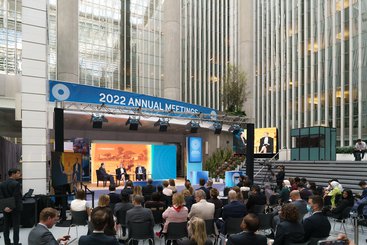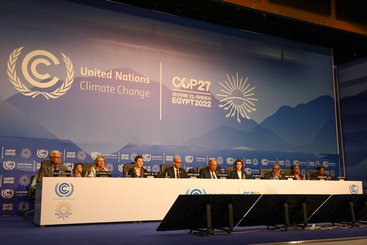The world needs to raise and steer more private finance to reach the Paris Agreement’s temperature and adaptation goals. In 2021, despite holding $379 trillion of the world’s finance assets, the private sector was responsible for just half of the $850 billion in global climate finance flows. Without directing more of this vast pool of money towards climate action, the world will fall short of the $3-6 trillion in annual investments needed to reach the Paris Goals.
A potential watershed moment came with the announcement of the Glasgow Financial Alliance for Net Zero (GFANZ) at COP26. Its 550 or so members – mostly large institutional investors controlling ~$150 trillion in assets – committed to science-based net zero targets underpinned by UNFCCC’s “Race to Zero”. But amid reports of a fractious alliance that members are threatening to quit, the UN-backed commitment was silently dropped just days before COP27 started in Egypt.
Has GFANZ failed to stand the test of time just a year after it was launched?
Coordinated action versus litigation risks
The UN’s “Race to Zero” is important because it lends scientific rigour to the 2050 net zero target. Many investors and corporates have made lofty long-term net zero commitments but failed to treat them with the urgency required to tackle the climate crisis.
“Race to Zero” holds investors to account over much shorter interim targets, requiring them to halve portfolio emissions by 2030 (‘50x30’ target). Given that GFANZ counts the world’s three largest fossil fuel financiers JPMorgan Chase, Citi and Bank of America among its members, achieving a 50% reduction in seven years almost certainly requires retirement or active environmental management of existing carbon-intensive investments, and definitely a stop to new investments in such assets.
But some members haven’t even gone as far as to impose exclusion lists on underwriting or investing in new thermal coal projects, citing that such industry-level, coordinated action would face litigation for breaching antitrust law. To ease membership criteria, the ‘Race to Zero’ commitment was therefore silently dropped in GFANZ’s latest annual report.
Ironically, the report pictures a freshly tarmacked road on its cover – a sign of business as usual?
The actual issue facing GFANZ
There is no longer much debate around the commercial attractiveness of clean investments. The cost-competitiveness of renewable energy in particular is increasing at an exponential rate. Annual growth of investments in clean energy have soared to 12% since 2020. Growth in solar is even more impressive at 33%.
Renewables are therefore awash with capital, with investments reaching a record high of $785 billion in 2021. This record will be broken again as countries wean themselves off expensive Russian gas. But these global figures hide a disturbing trend: clean energy investments in emerging market and developing economies (EMDEs) have declined from $73 to $68 billion between 2018 and 2021, largely due to a drop in foreign direct investment (FDI) from $22 to $15 billion.
This is a problem because climate finance needs are most pressing in EMDEs, where clean energy alone will require annual investments of $1 trillion. But the renewables boom is simply not reaching the countries that need it most. GFANZ itself acknowledges that current private climate finance flows to EMDEs are far from sufficient.
Why?
Pipelines, risks and costs of capital
The barriers to mobilizing capital to EMDEs are not restricted to climate finance. They can be broken down into three main issues: inadequate visibility of investible pipelines, low risk-adjusted returns and high costs of capital.
First, the ability to shift GFANZ capital to the Global South depends on the supply of commercially attractive investment opportunities at scale. Ticket sizes below $200 million are automatically screened out by most institutional investors. Although some renewable energy projects easily reach that bankability threshold, their number in EMDEs has shrunk. Most climate investments are plagued by lack of sufficient and standardised data based on interoperable and internationally aligned disclosure standards and taxonomies that classify such investments.
Second, the returns of climate-smart investments in the Global South are often too low for the level of real or perceived risks. Although returns are growing due to the increased cost-competitiveness of renewables, so too are risks due to the physical impacts of climate change, rising inflation, indebtedness and depreciation of currencies.
Third, renewable energy projects are sensitive to increased financing costs and risks because they are cheap to run but expensive to build. Currency risk has therefore been a persistent barrier to climate finance in developing countries. The US Federal Reserve’s interest rate hikes and resulting dollar strength have heightened that risk even further and instigated capital flight from EMDEs.
Underappreciated, underfunded and underutilised: National Development Banks (NDBs)
Development banks are well-placed to help address these challenges. Backed by the state, they are less risk-averse and able to provide the longer-term, affordable financing necessary for public goods. They also have a catalytic role to play in using blended finance mechanisms to create more favourable risk-adjusted returns for international private investors.
However, endeavours to mobilise private capital in EMDEs have often emphasised the role of multilateral development banks (MDBs). National development banks (NDBs), in contrast, have been somewhat side-lined despite obvious comparative advantages in addressing the above issues.
NDBs are deeply rooted in the national context, with unrivalled knowledge of local markets and long-standing relationships with local private and public sector actors. This often makes them better-placed to understand and price risks; build pipelines; originate investment opportunities; and intermediate public and private domestic and international capital.
They have also played an important role in shaping policies and developing local capital markets which can incentivise climate-smart investment within countries. NDBs such as PT SMI in Indonesia and NAFIN in Mexico were among the first issuers of green bonds in their respective countries, and thus played a pioneering role in kickstarting local green bond markets. These were used to tap into pools of international and domestic institutional capital.
However, to fulfil this role, NDBs must have enough capital to operate at the scale that is required. With a few exceptions, such as the China Development Bank, the Brazilian Development Bank (BNDES) and Germany’s KfW, most NDBs have small capital bases. In Africa, not only are NDBs relatively small, they struggle with high currency mismatch on their balance sheets. They need more support from government and international concessional finance to create these investment opportunities at scale.
What can GFANZ do?
The most obvious next step for GFANZ would be to pursue more partnerships with NDBs to identify, structure and deliver climate investments. That is not to say that they should replace the role of MDBs. They can complement them with comparatively advantageous knowledge about how to deploy capital locally and with catalytic effect.
Greater engagement between GFANZ and NDBs – with a climate lens – can also help build key capabilities within countries, for example through demonstration projects using frontier technologies and innovative financing instruments. Although most EMDEs have clean energy targets in place as part of their NDCs, fewer have more specific and effective mechanisms such as renewable energy auctions and feed-in-tariffs. The policy environment is even less developed in other sectors relevant to adaptation and mitigation goals, such as in sustainable buildings and sustainable agriculture.
This is an agenda that will take time and a good dose of realism. But GFANZ can start delivering on its promises by embarking on closer working relationships with NDBs across the Global South. It may be too late for COP27, but reaching a financing agreement with India’s new NDB, NABFID, ahead of its G20 presidency presents the perfect opportunity for COP28 in 2023.





